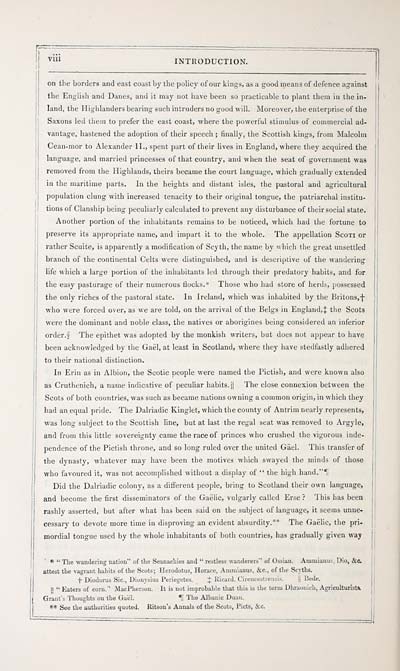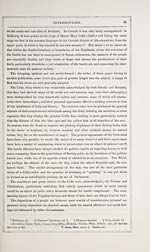Blair Collection > Sar-obair nam bard gaelach, or, The beauties of Gaelic poetry, and lives of the Highland bards
(18)
Download files
Complete book:
Individual page:
Thumbnail gallery: Grid view | List view

INTRODUCTION.
on the borders and east coast by the policy of our kings, as a good rneans of defence against
the English and Danes, and it may not have been so practicable to plant thein in the in-
land, the Highlanders bearing such intruders no good will. Moreover, the enterprise of the
Saxons led tliem to prefer the east coast, where the powerful stimulus of commercial ad-
vantage, hastened the adoption of their speech ; finally, the Scottish kings, from Malcolm
Cean-mor to Alexander II., spent part of their Uves in England, where they acquired the
language, and married princesses of that country, and when the seat of government was
removed from the Highlands, theirs became the court language, which gradually extended
in the maritime parts. In the heights and distant isles, the pastoral and agricultural
population clung with increased tenacity to their original tongue, the jjatriarchal institu-
tions of Clanship being peculiarly calculated to prevent any disturbance of their social state.
Another portion of the inhabitants remains to be noticed, which had the fortune to
preserve its appropriate name, and impart it to the whole. The appellation Scoti or
rather Scuite, is apparently a modification of Scyth, the name by which the great unsettled
branch of the continental Celts were distinguished, and is descriptive of the wandering
life which a large portion of the inhabitants led through their predatory habits, and for
the easy pasturage of their numerous flocks.* Those who had store of herds, possessed
the only riches of the pastoral state. In Ireland, which was inhabited by the Britons,-j-
who were forced over, as we are told, on the arrival of the Belgs in England,}: the Scots
were the dominant and noble class, the natives or aborigines being considered an inferior
order.§ The epithet was adopted by the monkish writers, but does not appear to have
been acknowledged by the Gael, at least in Scotland, where they have stedfastly adhered
to their national distinction.
In Erin as in Albion, the Scotic neople were named the Pictish, and were known also
as Cruthenich, a name indicative of pecuUar habits. || The close connexion between the
Scots of both countries, was such as became nations owning a common origin, in which they
had an equal pride. The Dalriadic Kinglet, which the county of Antrim nearly represents,
was long subject to the Scottish Hne, but at last the regal seat was removed to Argylej
and from this little sovereignty came the race of princes who crushed the vigorous inde-
pendence of the Pictish throne, and so long ruled over the united Gael. This transfer of
the dynasty, whatever may have been the motives which swayed the minds of those
who favoured it, was not accomplished without a display of " the high hand."l
Did the Dalriadic colony, as a different people, bring to Scotland their own language,
and become the first disseminators of the Gaelic, vulgarly called Erse ? This has been
rashly asserted, but after what has been said on the subject of language, it seems unne-
cessary to devote more time in disproving an evident absurdity.** The Gaelic, the pri-
mordial tongue used by the whole inhabitants of both countries, has gradually given way
* " The wandering nation" of the Seanachies and " restless wanderers" of Ossian. Amiuianu- , Dio, &C.
attest the vagrant habits of the Scots; Herodotus, Horace, Ammianus, &c., of tlie Scyths.
t Diodorus Sic, Dionysius Periegetes. J Ricaid. Cirencestrensis. § Bede.
1! " Eaters of corn." MacPherson. It is not improbable that this is the term Dhraonich, Agriculturists.
Grant's Thoughts on the Gael. U The Albanic Duau.
** See the authorities quoted. Ritson's Annals of the Scots, Ficts, &c.
J
on the borders and east coast by the policy of our kings, as a good rneans of defence against
the English and Danes, and it may not have been so practicable to plant thein in the in-
land, the Highlanders bearing such intruders no good will. Moreover, the enterprise of the
Saxons led tliem to prefer the east coast, where the powerful stimulus of commercial ad-
vantage, hastened the adoption of their speech ; finally, the Scottish kings, from Malcolm
Cean-mor to Alexander II., spent part of their Uves in England, where they acquired the
language, and married princesses of that country, and when the seat of government was
removed from the Highlands, theirs became the court language, which gradually extended
in the maritime parts. In the heights and distant isles, the pastoral and agricultural
population clung with increased tenacity to their original tongue, the jjatriarchal institu-
tions of Clanship being peculiarly calculated to prevent any disturbance of their social state.
Another portion of the inhabitants remains to be noticed, which had the fortune to
preserve its appropriate name, and impart it to the whole. The appellation Scoti or
rather Scuite, is apparently a modification of Scyth, the name by which the great unsettled
branch of the continental Celts were distinguished, and is descriptive of the wandering
life which a large portion of the inhabitants led through their predatory habits, and for
the easy pasturage of their numerous flocks.* Those who had store of herds, possessed
the only riches of the pastoral state. In Ireland, which was inhabited by the Britons,-j-
who were forced over, as we are told, on the arrival of the Belgs in England,}: the Scots
were the dominant and noble class, the natives or aborigines being considered an inferior
order.§ The epithet was adopted by the monkish writers, but does not appear to have
been acknowledged by the Gael, at least in Scotland, where they have stedfastly adhered
to their national distinction.
In Erin as in Albion, the Scotic neople were named the Pictish, and were known also
as Cruthenich, a name indicative of pecuUar habits. || The close connexion between the
Scots of both countries, was such as became nations owning a common origin, in which they
had an equal pride. The Dalriadic Kinglet, which the county of Antrim nearly represents,
was long subject to the Scottish Hne, but at last the regal seat was removed to Argylej
and from this little sovereignty came the race of princes who crushed the vigorous inde-
pendence of the Pictish throne, and so long ruled over the united Gael. This transfer of
the dynasty, whatever may have been the motives which swayed the minds of those
who favoured it, was not accomplished without a display of " the high hand."l
Did the Dalriadic colony, as a different people, bring to Scotland their own language,
and become the first disseminators of the Gaelic, vulgarly called Erse ? This has been
rashly asserted, but after what has been said on the subject of language, it seems unne-
cessary to devote more time in disproving an evident absurdity.** The Gaelic, the pri-
mordial tongue used by the whole inhabitants of both countries, has gradually given way
* " The wandering nation" of the Seanachies and " restless wanderers" of Ossian. Amiuianu- , Dio, &C.
attest the vagrant habits of the Scots; Herodotus, Horace, Ammianus, &c., of tlie Scyths.
t Diodorus Sic, Dionysius Periegetes. J Ricaid. Cirencestrensis. § Bede.
1! " Eaters of corn." MacPherson. It is not improbable that this is the term Dhraonich, Agriculturists.
Grant's Thoughts on the Gael. U The Albanic Duau.
** See the authorities quoted. Ritson's Annals of the Scots, Ficts, &c.
J
Set display mode to: Large image | Transcription
Images and transcriptions on this page, including medium image downloads, may be used under the Creative Commons Attribution 4.0 International Licence unless otherwise stated. ![]()
| Early Gaelic Book Collections > Blair Collection > Sar-obair nam bard gaelach, or, The beauties of Gaelic poetry, and lives of the Highland bards > (18) |
|---|
| Permanent URL | https://digital.nls.uk/81868084 |
|---|
| Description | A selection of books from a collection of more than 500 titles, mostly on religious and literary topics. Also includes some material dealing with other Celtic languages and societies. Collection created towards the end of the 19th century by Lady Evelyn Stewart Murray. |
|---|
| Description | Selected items from five 'Special and Named Printed Collections'. Includes books in Gaelic and other Celtic languages, works about the Gaels, their languages, literature, culture and history. |
|---|

